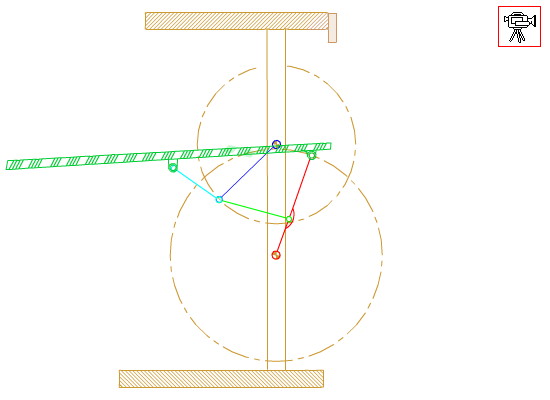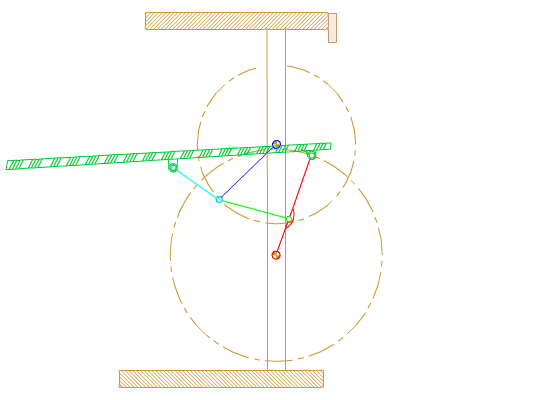3.6 Step-Wise Solution of the Loop Closure Equation
As shown in the previous section, for simple mechanisms the solution of the loop closure equations reduces to the solution of a triangular relation. The triangular relations can as well be solved analytically. In this approach, rather than obtaining an explicit function between the input variable and other position variables, our aim will be to obtain a set of equations which, when solved in steps, will yield the value of all the unknown variables. Such a solution is a closed form solution and, furthermore, it is very suitable for a numerical solution using a computer, programmable calculator, or even on a simple calculator.
As a first example, consider a problem in which we want to determine the position of all the links of an off-set slider-crank mechanism shown below for different crank angles q12. The link lengths denoted by a1, a2, a3 are known.
The vector loop equation is:
A0A = A0B + BA
In rectangular form, these vectors can be written as:
A0A = a2(cosθ12i + sinθ12j)
A0B = xi + a1j
BA = a3(cosθ13i + sinθ13j)
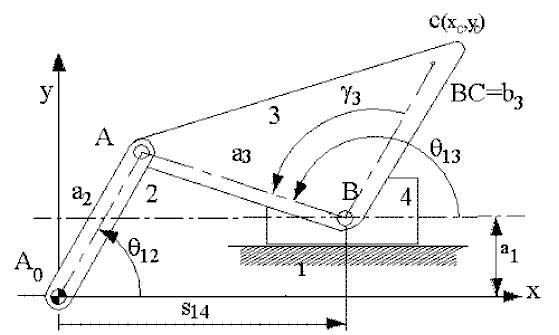
Equating x and y components separately, the loop closure equation will yield two scalar equations:
| a2cosθ12 = s14 + a3cosθ13 | (1) |
| a2sinθ12 = a1 + a3sinθ13 | (2) |
Rewriting these equations:
| sinθ13 = (a2sinθ12 − a1)/a3 | (3) |
| s14 = a2cosθ12 − a3cosθ13 | (4) |
For a given value of the input variable, θ12, one can solve for θ13 from (3) and substitute the values of θ13 and θ12 into equation (4) to obtain the corresponding value of s14. The variable s14 can be solved only after θ13 is solved from (c). If we are to determine the co-ordinates of a point C (xc, yc), we can write:
| xC = s14 + b3cos(θ13 − γ3) | (5) |
| yC = a1 + b3sin(θ13 − γ3) | (6) |
Again equations (5) and (6) can be solved only after equations (3) and (4) are solved.

Since the scalar equations obtained from the loop closure equations are non-linear, the method of solution will differ from one mechanism to the other. The method used for the analysis of a four-bar is known as the Raven’s Method. In the four-bar mechanism shown above, the link lengths (a1, a2, a3, a4) are given. We would like to determine the position of all the links for a given value of the input variable, q12.
Similar to the method used in geometrical analysis, first consider the triangle A0AB0. Since the two sides (a1, a2) and the included angle (q12) are known, for this triangle the length of the third side (AB0 = s) and angle ϕ of the triangle can be determined. Note that the length, s, and angle ϕ are variable. Using the cosine theorem:
| s = \displaystyle \sqrt{{{{\text{a}}_{1}}^{2}+{\text{a}_{2}}^{2}-2{\text{a}_{1}}{{\text{a}}_{2}}\cos{{\text{θ}}_{{12}}}}} | (1) |
| ϕ′ = cos-1 \displaystyle \left[ {\frac{{{{\text{a}}_{1}}^{2}+{{\text{s}}^{2}}-{{\text{a}}_{2}}^{2}}}{{2{{\text{a}}_{1}}\text{s}}}} \right] (ϕ = π − ϕ′) | (2) |
Another form of calculating s and ϕ′, especially when a calculator has polar-to-rectangular conversion key, is to equate the x and y components:
| s cosϕ = a2cosθ12 − a1 (horizontal component of B0A) | (1′) |
| s sinϕ = a2sinθ12 (vertical component of B0A) | (2′) |
Now, if the values on the right-hand side of these equations are determined and if a rectangular-to-polar conversion is made, one will obtain s and ϕ as the output directly. This will give the correct quadrant for the angle ϕ at every instant. In computers a similar result can be obtained by using inverse tangent function with double argument (ATAN2 (xs, ys)) to obtain the correct quadrant for ϕ.
Referring to the triangle ABB0 and applying cosine theorem:
| μ = cos-1 \displaystyle \left[ {\frac{{{{\text{a}}_{3}}^{2}+{{\text{a}}_{4}}^{2}-{{\text{s}}^{2}}}}{{2{{\text{a}}_{3}}{{\text{a}}_{4}}}}} \right] | (3) |
| ψ = cos-1 \displaystyle \left[ {\frac{{{{\text{a}}_{4}}^{2}+{{\text{s}}^{2}}-{{\text{a}}_{3}}^{2}}}{{2{{\text{a}}_{4}}\text{s}}}} \right] | (4) |
The magnitudes of ϕ′ and ψ are both less than 180° and ψ is always positive. If equations (1) and (2) are used, than the sign of f’ must be checked (if you use rectangular-to-polar conversion the calculator gives the correct quadrant). The sign of sinϕ′ must be of the same sign as sinθ12. The plus or minus sign for m refers to two different solutions of a four-bar mechanism as shown in the figure. The angle μ is known as the “transmission angle” whose importance is explained in Chapter 7.
The unknown position variables θ13 and θ14 can be easily determined as:
| θ14′ = ϕ + ψ | (5′) |
| θ13′ = θ14 + μ | (6′) |
Hence, we have obtained a set of equations which must be solved in steps.
In case of an inverted slider-crank mechanism shown below, the equations for the total position analysis are:

In case of an inverted slider-crank mechanism shown above, the equations for the total position analysis are:
| p cosϕ = a2cosθ12 − a1 | (1) |
| p sinϕ = a2sinθ12 | (2) |
(when solving with a calculator, use P – R conversion to determine p and ϕ)
|
ψ = cos-1(a4/p) s = \displaystyle \sqrt{{{{\text{p}}^{2}}-{{\text{a}}_{4}}^{2}}} θ14 = ϕ ± ψ |
(3) |
| (4) | |
| (5) |
The derivation of these equations is left as an exercise (As a hint, the solution of the two triangles A0AB and AB0B in steps results with the above equations).
In great many mechanisms, the stepwise solution will require the solution of four-bar, slider-crank or inverted slider-crank loops in steps. For example, the quick-return mechanism shown below links 1, 2, 3 and 4 form an in-line inverted slider-crank mechanism while links 1, 4, 5 and 6 form a slider-crank mechanism. For a given value of the input variable, θ12, the angle θ14 and s can be determined. In case of the slider-crank mechanism, with θ14 as the input variable, the position variables θ15 and s6 are found. In such an analysis, one must be concerned with the reference axes and how the variables are to be measured with respect to the reference axes.
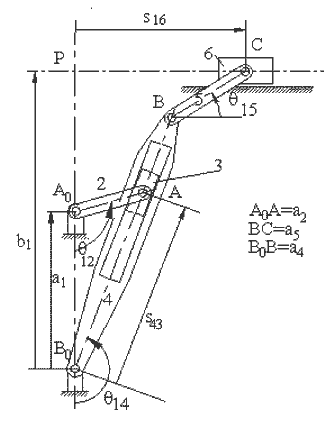
s43cosθ14 = a2cosθ12 − a1
s43sinθ14 = a2sinθ12
θ15 = sin-1 \displaystyle \left[ {\frac{{{{\text{a}}_{4}}\cos{{\text{θ}}_{{14}}}+{{\text{b}}_{1}}}}{{{{\text{a}}_{5}}}}} \right]
s16 = a4sinθ14 + a5cosθ15
The first two equations are the solution of the triangle A0AB0. The last two equations are the solution of the slider crank mechanism formed by links 1, 4, 5 and 6.
Example:
Consider the six link mechanism shown which is used as a garage door. We are to determine the position of the links when the input crank angle θ12 is given. Let |A0B0| = a1; |A0A| = a2; |A0D| = b2; |AB| = a3; |BC| = b5; |BB0| = a4; |CD| = a6.
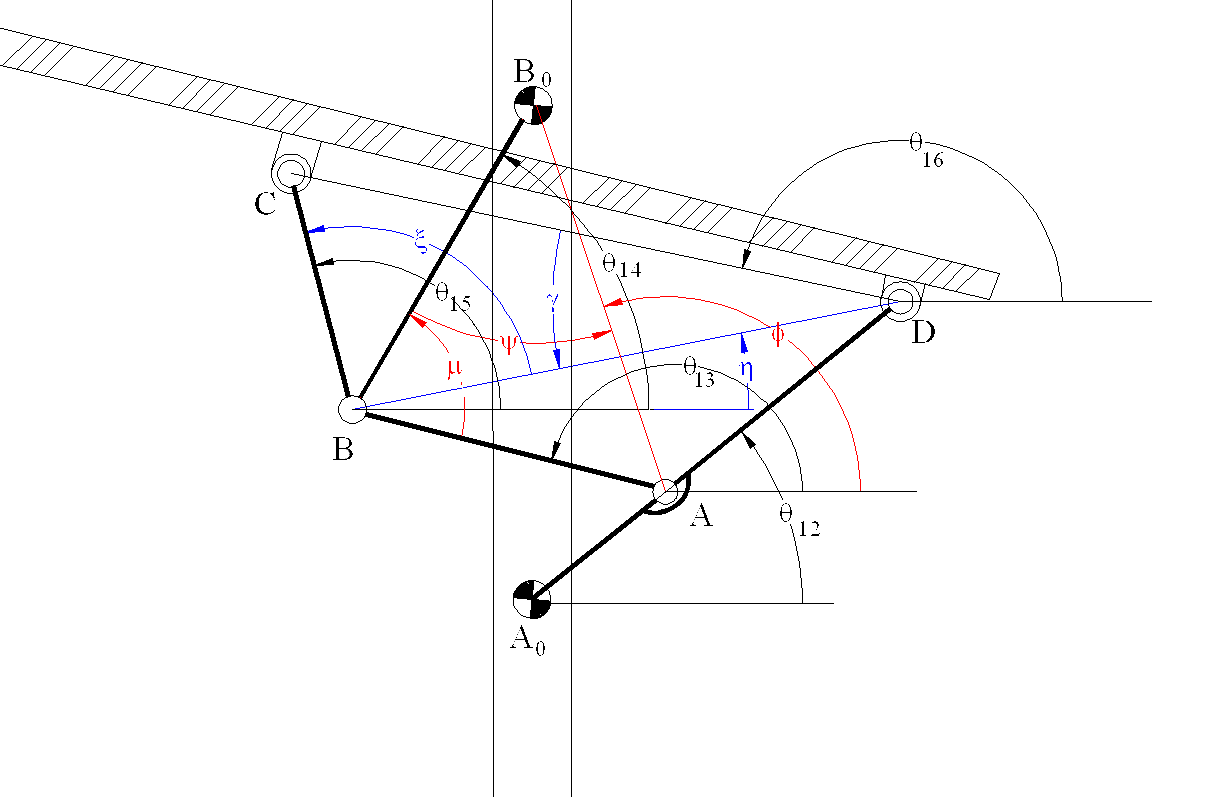
Noting that the links 1, 2, 3, 4 (A0ABB0) form a four-bar mechanism, referring to the equations derived for the four-bar:
s cosϕ = −a2cosq12 : Horizontal component of AB0 = xs
s cosϕ = −a2cosq12 + a1 : Vertical component of AB0 = ys
|B0A| = s = \displaystyle \sqrt{{{\text{x}}_{\text{s}}}^2+{{\text{y}}_{\text{s}}}^2} ; f = tan-1(xs; ys)
μ = cos-1 \displaystyle \left( {\frac{{{{\text{a}}_{3}}^{2}+{{\text{a}}_{4}}^{2}-{{\text{s}}^{2}}}}{{2{{\text{a}}_{3}}{{\text{a}}_{4}}}}} \right)
ψ = cos-1 \displaystyle \left( {\frac{{{{\text{a}}_{4}}^{2}+{{\text{s}}^{2}}-{{\text{a}}_{3}}^{2}}}{{2{{\text{a}}_{4}}\text{s}}}} \right)
θ14 = ϕ − ψ
θ13 = π − μ + θ14
ψ, ϕ and μ are as defined for the four bar mechanism in the figure. The coordinates of points B and D relative to an xy-frame with center A0 are:
xD = b2cosθ12
yD = b2sinθ12
xB = −a4cosθ14
yB = a1 − a4sinθ14
The distance BD and the angle it makes with the horizontal is:
|BD| = s′ = \displaystyle \sqrt{{\left({\text{x}}_{\text{D}}-{\text{x}}_{\text{B}}\right)}^2+{\left({\text{y}}_{\text{D}}-{\text{y}}_{\text{B}}\right)}^2}
η = atan2(xD − xB; yD − yB)
From the triangle BDC:
ξ = cos-1 \displaystyle \left( {\frac{{{{\text{a}}_{5}}^{2}+{{\text{s}}^\prime}^{2}-{{{\text{a}}_{6}}^{2}}}}{{2{{\text{a}}_{5}}{{\text{s}}^\prime}}}} \right)
γ = cos-1 \displaystyle \left( {\frac{{{{\text{a}}_{6}}^{2}+{{\text{s}}^\prime}^{2}-{{{\text{a}}_{5}}^{2}}}}{{2{{\text{a}}_{6}}{{\text{s}}^\prime}}}} \right)
and
θ15 = η + ζ
θ16 = η + π − γ
Hence all the unknown position variables are determined in steps.These equations are valid for every position of θ12. Note that these equations can be solved in steps (one after another). If the independent variable was selected as the angle of the door θ16, then these equations must be solved simultaneously.
